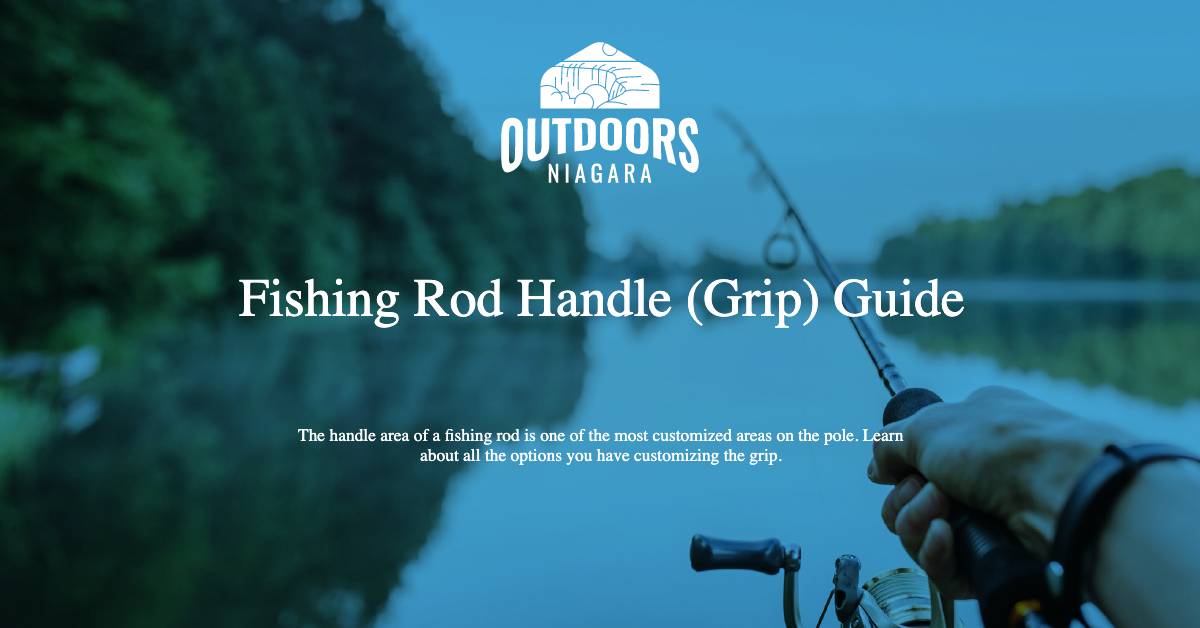The handle area of a fishing rod is one of the most customized areas on the pole. It sits just beneath the reel and just slightly above the reel.
It is where you grip the pole, and anglers use various materials to “improve” the grip. In this blog, we go over pole grips, materials, and applications.
Contents
How Do You choose a fishing rod handle (grip)?
There are a few ways to approach the choice of a rod grip for your fishing pole. Those include:
- Ergonomics and Comfort — Fishing requires some strength in your hands. After all, you must hold onto the pole for hours, and if you are battling a big fish, your grip becomes a critical factor. A comfortable rod grip is essential. It should allow you to hold onto the rod with a lot of force and when trolling or casting.
- For Protection of the Blanks — The blank is the core of a fishing rod. It is the material that makes up the pieces of the pole itself. In some fishing situations, especially in salt water, the material of the grip can absorb water. For that reason, you want a rod grip that helps stop water from getting under the rod grip.
Those two factors are essential points to consider when choosing a rod grip for your fishing pole.
What Are Different Materials Used for Rod Grips?
There are a ton of materials that you can use for rod grips. Some come as kits, and others are DIY. Here is a sampling of some of the most popular materials for rod grips:
- Cork — is a traditional material that lasts. It has a little give to it, so it is comfortable. Cork also comes in cork rings, which you can order. Cork does not have a lit of give to it, so be sure that you measure the rod blank and butt of the rod before you order. Cork is also getting harder to find as many of the cork oak trees were cut down. One of the best pros for using cork is that the grips hold up in freshwater and saltwater, especially for inshore fishing. Another pro is that you can lightly alter the cork rings so that they better fit your hand. All you need is a piece of fine-grained sandpaper.
- Cork Tape — it is a tape with cork particles adhered to it. It will do okay, but don’t expect it to last long. One pro about using cork tape is that it is pretty cheap. It has some endurance to it and makes an okay application for shore fishing.
- Shrink Wrap — Less of a grip and more of a jacket; shrinkwrap makes a decent overcoat for other types of hand grips for your rod. Shrinkwrap can be an excellent product to help keep rod handles dry, sand out of the grip, and extending the life of the grip. A pro is that it works well with saltwater fishing, especially for inshore anglers.
- EVA Foam — is a standard grip material for store-bought rods. It is also very comfortable. Because it is soft, you can gently sand it for a more ergonomic fit to your hand. If you replace only one section of rod grip, EVA foam will go where you hold the rod the most. Generally, that is the fore-grip area. A pro is that these are good for freshwater fishing and saltwater fishing. A con is that they are very unforgiving when applying them to the rod. Be sure to measure the diameter of the rod blank and compare that to the EVA foam inner diameter. It is foam, and it will rip.
- Hypalon — is extruded rubber and offers a higher level of durability to many hand grips for fishing rods. Hypalon’s durability makes it perfect for charter fishing, long fishing trips on a boat, trolling, and more. Hypalon is easier to add to your rod as it is stretchy and more so than foam. It is soft and comfortable to hold for long hours, and you can alter it a bit with sandpaper to make a better fit.
- Cord — is one of the most durable materials to add to your fishing pole for a few reasons. One wet or dry, it is easy to grip. A con is that it can be heavy. It is easily one of the hardest grips to apply if you are adding it to your pole as a DIY project. Another con is that cord is thick, and it can mask bites and strikes.
- Carbon Fiber — offers a very durable and lightweight grip for fishing poles. These come premade, and one pro is that you can find them in many sizes. Another pro is that the thin material does not mask the feel of the rod.
- Paracord — is more of a fashionable pole grip. Everyone is into paracord for many uses. You can use paracord as a pole grip, but it is a DIY project. Best to start with some underlayment like cork tape. Some folks use urethane as a coating for the cord once it is in place. Like other cordings, the paracord can mask sensation from the pole.
- Wood — grips are also a good option. You find these a lot on custom poles. They can be heavy, but they resonate well with the rod action. You may need to maintain them periodically with a bit of sanding and then a sealant. A pro for wood grips is that they stay cool in summer and somewhat warm in winter. They also are durable.
What are the different types of grips for fishing rods?
There are a variety of grip styles for fishing, and each differs in what it offers. Here is a shortlist:
- Pistol Grip — rods offer a little more accuracy when casting for flicking your line in tight quarters. Otherwise, they are primarily out of style. It is a thicker and broader grip for short-handled poles. They are often used for freshwater fishing where the pole is shorter. They can improve accuracy when casting but may or may not fit comfortably in your hand.
- Trigger grip — Technology announcements make longer and lightweight fishing rods more durable and give the same result as the pistol grip.
- Split Grip — is one of the more popular modern grips for fishing poles. They include two grips – one above the reel and one below. Perfect for holding the rod while battling big fish.
How to Choose a Casting Rod
Learning how to choose a casting rod comes down to a few factors:
- The fish you target
- The environment where you fish — close quarters, off the docks, from shore, from a kayaked, etc.
- The Weather — makes grip choice important such as fishing in rough and windy, clear and still, etc.
The grip you choose will play a part in how well you cast.
The trigger and pistol grips help you be accurate in close quarters or from a kayak or canoe.
A split grip gives you an edge on long-distance casting from shore or a boat.
It is not uncommon to find various grips in a fishing pole collection from an avid angler.
They have learned when to choose which type of grip and how to use them.
We hope that this short guide helps you master grip choice and makes you a better angler.







